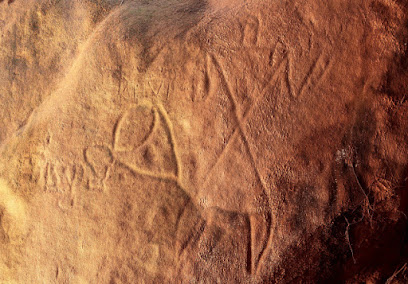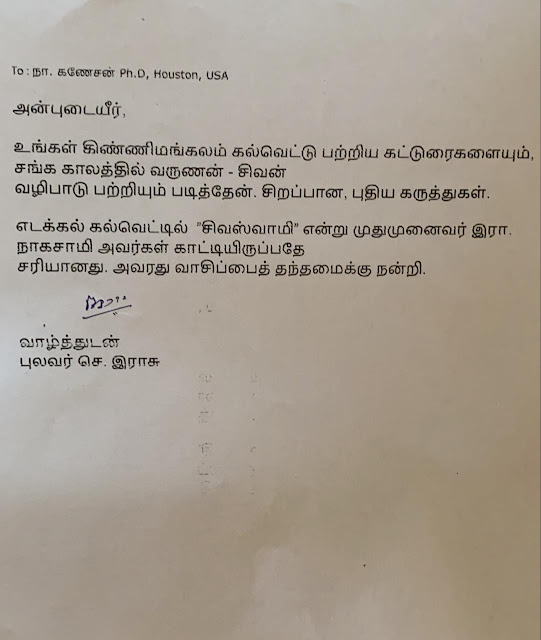சங்க காலத்தில் சைவம்
வருணனில் இருந்து சிவபிரானுக்கு மாறும் இலிங்க வழிபாடு
(1) சங்க காலத் தொடக்கம் காட்டும் வருணனின் லிங்க வழிபாடு
தொல்காப்பியத்திலே சிவன் என்ற பெயரோ, லிங்க வழிபாடோ பற்றிய குறிப்புகள் இல்லை. ஆனால், சிவபிரானைப் பற்றிப் பல செய்திகள் உண்டு. சங்க காலத்திற்கு முன்பும், சங்க காலம் தொடங்கும் கி.மு. 300 வாக்கிலும் லிங்க வழிபாடு வேதத்தின் பெருந்தெய்வம் வருணன் மீதாக இருந்துள்ளது. உதாரணமாக, இந்தியாவில் கிடைக்கும் லிங்கங்களில் மூத்த குடிமல்லத்தில் இருப்பது நெய்தல் திணையின் கடவுள் வருணன் எனக் காட்டியுள்ளேன் [1]. இவன் கி.மு. மூன்றாம் நூற்றாண்டைச் சார்ந்தவன். சங்க கால இறுதிக் கட்டத்திலே, வருணன் வழிபாட்டின் இலிங்கக் குறி சிவனுக்கு என மாறுகிறது. இதில் முக்கியப் பங்காற்றினோர் பஞ்ச திராவிட தேசங்களில் வாழ்ந்த திராவிட மொழிகளைப் பேசும் மக்கள் ஆவர். இந்த மாற்றத்தைச் சுருக்கமாக, மாணிக்கவாசகர் “தென்னாடுடைய சிவனே போற்றி! எந்நாட்டவர்க்கும் இறைவா போற்றி! “ எனச் சிறப்பாகப் பாடினார். பஞ்ச த்ராவிட தேசத்தின் வடக்கே காரோணத்தில் (காயாரோஹணம், குஜராத்) நகுளீசர்( > லகுளீசர்) தம் காலத்துக்கு முன்னிருந்த பல்வேறு சைவ சமயப் பிரிவுகளை ஒருங்குபடுத்தி பாசுபத சைவத்தைத் தாபித்துப் பாரத தேசமெங்கும் பரப்பினார். எனவே, சைவ சமயத்தின் ஆதி குருவாக நகுளீசர் போற்றப்படுகிறார். தமிழ்நாட்டில் தென்முகக்கடவுள் (தக்ஷிணாமூர்த்தி) உள்ள சிவன் கருவறைக் கோஷ்டத்தில் நகுளீசன் கர்நாடகத்திலும், வடக்கேயும் இடம்பெறுவதைப் பார்க்கலாம். சோழமண்டலம் சோடமண்டலம்/சோரமண்டலம். சோழப் பேரரசி பாட்டி ஆனதால், ஒரிசா நாட்டு மன்னன் கஜபதி அனந்தவர்மன் சோடகங்க தேவன் என அழைக்கப்பட்டான். சோழ> சோடமண்டலம் > சோரமண்டலம் (Coromandal) ஆதற்போலே, கோடு என்னும் சொல் தரும் கவடி/கவரி என்னும் சொல் கௌரீ எனப் பார்வதிக்குப் பெயராக அமைந்தது [2]. பழைய சில்ப சாஸ்திரங்களிலே கௌரியை வருணன் மனைவியாக வடிக்கவேண்டும் என்று சொல்லியிருக்கிறது. கௌரியின் சின்னமாக, முல்லைத் திணையிலே ஆயர்கள் பெண் எருமையின் கொம்பை மணவறையில் வைத்து தங்கள் வீட்டுக் கலியாணங்களை நிகழ்த்தியுள்ளனர் என்கிறது சங்க இலக்கியம். இதற்கு ஆதாரமாக, கருவூரிலே எருமையைக் கொண்ட வெள்ளி மோதிரம் கிடைக்கிறது (படம் 1).
1. Water Buffalo on silver ring. Sangam Age, uninscribed silver 'buffallo' seal (200-100 BC), facet width 19.75mm, length 19.12 mm, height 7.7 mm, weight 4g. Facet has negative impression of a buffalo walking to left.
2. Makara (Gharial) on gold ring (Vellalur near Coimbatore)அதன் அருகிலே வெள்ளலூரில் வருணனுக்கான மகரம் (கங்கை முதலை, Gharial) கொண்ட தங்கத்தால் இயன்ற மோதிரம் கிடைத்துள்ளது (படம் 2). இதே போல, சங்க கால நாணயங்களும் உள்ளன. கொற்றவைக்கு எருமைக் கொம்பு வழிபாடு போன்றே, மகர மீனின் கொம்பை வைத்து வருணன் வழிபாடு சங்க காலத்தில் இருந்திருக்கிறது. முசிரிப் பட்டினத்தில் தங்கத்தில் ஆன மழு ஆபரணம் வருணன் வழிபாட்டுச் சின்னமாகக் கிடைத்துள்ளது (படம் 3).
3. Golden Axe pendent (Muziris Pattinam)எருமைக் கொம்பைக் குறியீடாக வைப்பது தோடர் வாழ்வியலில் முக்கியமானது. எருமைக்கொம்பு வடிவில் சுடுமண் சிற்பங்கள் சிந்துவெளியின் அகழாய்வில் பல கிடைக்கின்றன (படம் 4). இது கொற்றவை வழிபாட்டின் 4000+ ஆண்டுக் குறியீடாக இருக்கலாம். சிந்து சமவெளியில் எருமைக் கொம்பை பெரிய தாழிகளில் காட்டியோ, எருமைக் கொம்பு தரித்த தலையில் கொம்பின் நடுவே இரு விண்மீன்களைப் பொறிப்பர் (படம் 5). எனவே, இது கொற்றித் தெய்வம் தொடர்புடையதாகும் ( Asko Parpola, Deciphering the Indus Script, Cambridge University Press, 1994).
4. Terracotta Buffalo Horns from Bhirrana (Indus site, Haryana)5. Indus Pot with Buffalo Hornsதொல்லியல், கலைவரலாற்றுத் துறை அறிஞர் இரா. நாகசாமி அவர்கள் துடி (hourglass) போன்ற உடல் (torso) கொண்ட வலை வீசும் மீனவன் போன்ற வடிவுடன் கூடிய பாறைச் சிற்பத்துடன் “சிவஸ்வாமி” என்று எழுதியிருப்பதை 2012-ல் அறிவித்தார் (படம் 6).
6. Edakkal Cave inscription : civasvāmi (Reading by Dr. Nagaswamy, Fig. 7)
நெய்தல் நிலக்கடவுள் வருணன் ஆகிய மீனவன் என்று காட்ட ”சிவஸ்வாமி” எழுத்தை அடுத்ததாகத் தொட்டுக்கொண்டு மீன்வலை விரிந்த நிலையில் உள்ளது. கையில் ஏதோ ஒன்றை (மீன்துண்டு?மழு?) வைத்துள்ள Anthropomorph. முனைவர் நாகசாமி எழுதிக் காட்டிய எடக்கல் பிராமிச் சொல்லை இணைத்துள்ளேன் (படம் 7).
7. சிவஸ்வாமி - Edakkal inscription near fisherman Varuṇa
இந்தச் சிற்பமும், பிராமி எழுத்தும் கண்டுபிடித்த எம். ஆர். ராகவ வாரியர் “ஸ்ரீ வழுமி” எனப் படித்தார் (The Hindu, Feb. 9, 2012). ஐராவதம் மகாதேவன் “ஈ பழம” என இந்தப் பிராமிக் கல்வெட்டை வாசித்தார் (The Hindu, June 7, 2012). புலவர் செ, இராசு (ஈரோடு) மூன்று வாசிப்பையும் படித்துப் பார்த்து ஆராய்ந்தபின், டாக்டர் ரா. நாகசாமி அவர்களின் வாசிப்பே பொருத்தமானது என்று குறிப்பிட்டார். காலம் கி.பி. ~300. ”சி” என்னும் முதலெழுத்தை (Cf. திருநாதர்குன்று வட்டெழுத்து, கி.பி. 5-6ம் நூற்றாண்டு) ஸ்ரீ என்றாக்கிவிட்டார் ராகவ வாரியர். ஆனால், ”வ”, ”மி” என்னு எழுத்துகளைச் சரியாகக் குறிப்பிட்டுள்ளார். வாரியர் ”ழு” என்றும், ஐராவதம் ”ழ” என்றும் படித்த கூட்டெழுத்து “ஸ்வா” என்பதன் பிராமி லிபி ஆகும். ஆதிச்சநல்லூர் முதுமக்கள் தாழியின் உள்ளே கிடைத்த பானையோட்டுச் சிற்பத்தில் கொற்றவை எடக்கல் சிற்பம் போலவே துடி போன்ற உடல் (torso) கொண்டும், அருகில் கலைமான் ஊர்தியுடனும், அவள் கணவன் வருணன் மகரம் ஆகவும் காட்டப்பட்டுள்ளனர் (படம் 8). நெல்லம் பயிரும், நெல்மணிகளும், நெல்வயலில் உள்ள கொக்கும் ஆதிச்சநல்லூர் முதுமக்கள் தாழியுள் புதைக்கப்பட்டவன் வேளிர் குடியினன் எனக் காட்டுகிறது. நெட்ரம் பாக்கம் சிவாலயத்தில் தமிழ் பிராமி எழுத்துடன் உள்ள லிங்கத்திலும் கழியினில் நெய்தல் மலர்கள் நெய்தல் திணைத் தெய்வதம் வருணனைக் குறிக்கக் காட்டப்படுதலை ஓர்க. இலங்கைத் தீவில் இணுவில் சிவாலயத்தில் லிங்கம் ஒன்றில் தமிழ் பிராமிக் கல்வெட்டு உள்ளது எனப் பேரா. சி. பத்மநாதன் தெரிவித்துள்ளார்.
8. Adichanallur pottery inside a burial urn - Koṟṟavai and Varuṇa (Makara)(2) Varuṇa transitioning to Śiva in Edakkal cave, Netrambakkam and Kinnimangalam near the end of Sangam era
The male anthropomorphic figure in Edakkal represents the transitional stage in which Vedic deity Varuṇa morphs into Śiva, the great god of Hinduism (Figure 5) and has a Brahmi inscription, civasvāmi (Figure 6) as read by Dr. R. Nagaswamy. The anthropomorphic figures have a long history such as the female Koṟṟi found inside a burial urn in Adichanallur (Figure 7). On October 12, 2012, Dr. Nagasamy wrote his finding to me: "Dear Ganesan, I have carefully studied the Edakkal inscription carefully and of the opinion that it is not a Vatteluttu record, but in Brahmi letters and reads civasvaami . The first letter is ci, the second letter is va, the third letter is svaa, a conjunct consonant, s + vaa and the last letter is mi. It is the name of the figure by the side. Please have a look at the writing again. The third letter is sa above and va below with a sign shown as horizontal line on the sa. There could be no doubt. I agree with you that the figure is contemporary with the inscription. R.N.”
Note the hourglass-like torso in both of them as in Bhirrana (Haryana) Indus pottery. Long before the Edakkal image, Anthropomorphic Axe figures are found in Yamuna-Ganga doab region in Post-Harappan period and with Iron chisel technology, they have been made into huge Anthropomorphic Axe sculptures in Tamil Nadu in the Megalithic period [1]. Archaeologists call these figures as “Anthropomorphic Axe” (AA) and Sangam literature calls these AA icons by its ancient native name, “maḻuvāḷ neṭiyōṉ” (Great god in the shape of Axe weapon).
At the beginning of Sangam era, Linga worship belonged to the Vedic supergod, Varuṇa, the prime example of which is Gudimallam Viḍangar representing Varuṇa which is the oldest Linga in India dated to 3rd century BCE by scholars like Ananda Coomarawamy. At the end of Sangam period, Pāśupatha Śaivism, unified by gurus like Nakulīsa, reaches Tamil country. This is seen in poems associated with Chera country, the capital of which was Vanji (Karur) in Kongu region. We can see for the first time, the Vibhūti smearing "vari-nīṟu" in Chera Keeran's song of Puṟam 249. Also, now Tolkāppiyar's Puḷḷi principle is exhibited fully in Kinnimagalam Linga in 2nd century CE. I have written a research article on how the most recent Tamil Brahmi find with five puḷḷi-s in Kinnimangalam linga affirms to the life-long research results of Sri. Iravatham Mahadevan showing the date of occurrence of Puḷḷi and hence, Tolkāppiyam's most important sutras about Tamil script. This gives us a date about Tolkāppiyar’s period as belonging to second century CE, while the origins of the first Tamil grammar may stretch few centuries before him. According to Colliṉ Celvar R. P. Sethuppillai, Kiṇṇimangalam's Sangam era name was Kiḷḷimangalam, and there a poet Chera Kōvanār wrote a Narriṇai poem. Perhaps, this Chera Kovan's relative got the paḷḷiippaḍai temple in Kinnimangalam. For all later Pallippadai temples in South India (for example, the Ganga Raja's paḷḷiippaḍai in Chozhapuram, near Velur, in 9th century) and in South East Asia "Devarāja cult" Hindu temples, the three Lingas with Tamil Brahmi at Netrambakkam, Kinnimanglam and Inuvil (Sri Lanka) form the source.
N. Ganesan, PhD
 9.
Bhirrana pottery - Compare this 4000 years old torso with Adichanallur
pottery (~600 BCE) in Figure 8 and Edakkal cave fisherman in Figure 6.
9.
Bhirrana pottery - Compare this 4000 years old torso with Adichanallur
pottery (~600 BCE) in Figure 8 and Edakkal cave fisherman in Figure 6.References:
[1] Indus Crocodile Religion as seen in the Iron Age Tamil Nadu, 2016, Bangkok, Thailand. https://archive.org/details/IVCReligionInIronAgeTamilNaduByNGanesan-2016-16thWSC
[2] Kavari in Tirukkuṟaḷ and Sangam Texts: Dravidian word for Gauṛ bison and
Tibetan yak, Nagercoil, 2017. http://nganesan.blogspot.com/2017/11/kavarimaa-tirukkural-conference-2017.html
[3] Kinnimangalam Tamil Brahmi inscription with 5 Puḷḷi: http://nganesan.blogspot.com/2020/07/ekamukha-linga-with-tamil-brahmi.html
[4] Netrampakkam and other Lingas with Tamil Brahmi:
https://groups.google.com/g/vallamai/c/v_ia2fnsyq0/m/sUNfiPqeAwAJ
[5] M. R. Raghava Varrier on the reading of “ee pazhama” in Edakkal inscription
“The Brahmi script etched in primitive rocks is said to belong to the 3rd century and translated as "Ee Pazhama" [this (is) ancient]. Many linguists in Kerala cried foul over the hype over this recent find. Well-known historian Dr M R Raghava Warrier, a specialist in Edakkal cave inscriptions, stated that this would be a 'dangerous interpretation of the script'. "It is a dangerous claim, and by all means it looks like they are reading too much into these two words. The government has evaded discussions with linguists outside this committee. This shows that the government is rather impatient and have an unscientific approach to the whole process," Dr Warrier told TOI. Noted historian Dr M G S Narayanan said that a detailed study has to be done before going public with it.”
புலவர் செ. ராசு, எடக்கல் கல்வெட்டில் ரா. நாகசாமி அவர்கள் படித்ததே சரியானது என்றும், இக்கட்டுரையில் உள்ள வருணன் சிவனாக மாறுதல் கோட்பாட்டைப் பற்றியும் எழுதியிருந்தார். அது இணைப்பில்.













6 comments:
புதிய தடயங்கள். மாறும் வரலாறு.
சங்க கால வரலாற்றின் பக்கங்களை முழுமையாகத் தெரிந்து கொண்டும் , அவை உலக அளவில் எவ்வாறு மாற்றங்களுக்கு உட்பட்டு இருந்தது என்பதையும் , அதனால் பெறப்படும் தகவல்கள் குறித்தும் ஆய்வு செய்து இதனை வெளியிட்டு உள்ளீர்கள்.காலம் தோறும் கிடைக்கும் வரலாற்று தரவுகளே வரலாற்றை மாற்றி அமைக்க உதவுகின்றன என்பதை உணர்ந்து செய்திருக்கும் தங்கள் பணி போற்றுதற்குரியது.
Nice
மிகச் சிறந்த விளக்கம்
மாமழை போற்றுதும் என இளங்கோ அடிகள் பாடுவதில் ஏதேனும் நுட்பம் இருக்குமோ?
ஆய்வுக்கட்டுரை ஓர் ஆழமான அலசல்.
மாமழை போற்றுதும் என இளங்கோ அடிகள் பாடுவதில் ஏதேனும் நுட்பம் இருக்குமோ?
ஆய்வுக்கட்டுரை ஓர் ஆழமான அலசல்.
Post a Comment